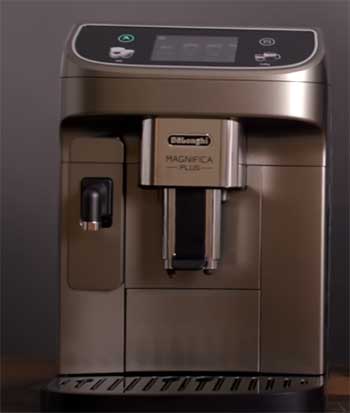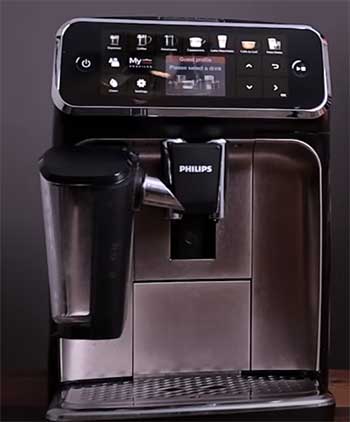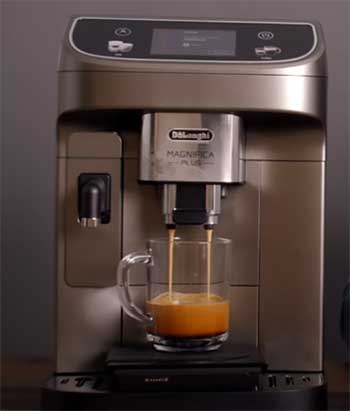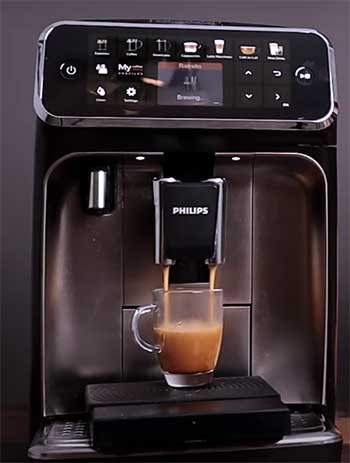I’m a coffee enthusiast who’s spent countless mornings tinkering with espresso machines, chasing that perfect crema-topped shot. The DeLonghi Magnifica Plus and Philips 5400 LatteGo are two super-automatic machines that promise café-quality drinks with push-button ease.
In this article, I’ll compare these machines head-to-head, breaking down their features, performance, and quirks to help you decide which one deserves a spot on your countertop.
From espresso quality to milk frothing, maintenance, and value, I’ll share my real-world experience to guide your choice.
A Brief Comparison Table
| Feature | DeLonghi Magnifica Plus | Philips 5400 LatteGo |
| Price (Approx.) | $799–$999 | $629–$799 |
| Grinder | Stainless steel conical burr, 13 settings | Ceramic flat burr, 12 settings |
| Drink Options | 14 (espresso, cappuccino, latte, iced, etc.) | 12 (espresso, latte macchiato, flat white, etc.) |
| Milk System | LatteCrema (automatic, customizable) | LatteGo (tubeless, dishwasher-safe) |
| Brew Time (Espresso) | 25–30 seconds | 14–18 seconds |
| User Interface | 3.5″ color touchscreen, app control | TFT screen, tactile buttons |
| Customization | High (strength, volume, milk texture) | Moderate (strength, volume) |
| Water Tank Capacity | 1.8L, removable | 1.8L, removable |
| Bean Hopper Capacity | 250g | 275g |
| Dimensions (H x W x D) | 14 x 9.4 x 17.3 in | 14.6 x 9.7 x 17.1 in |
| Weight | 21.2 lbs | 17.6 lbs |
| Warranty | 2 years | 2 years |
My Journey With Super-Automatic Espresso Machines
I’ve been hooked on espresso since my first sip at a tiny café in Rome years ago. That rich, velvety shot ruined me for instant coffee forever.
Since then, I’ve owned everything from manual lever machines to pod-based systems, but super-automatic machines like the DeLonghi Magnifica Plus and Philips 5400 have become my go-to for convenience without sacrificing quality.
These machines grind, tamp, brew, and froth milk at the touch of a button, making them perfect for busy mornings or when I’m entertaining guests. Let’s see how they stack up.
First Impressions of DeLonghi Magnifica Plus And Philips 5400

When I unboxed the DeLonghi Magnifica Plus, its sleek, compact design caught my eye.
At 14 inches tall and 9.4 inches wide, it’s a space-saver, ideal for my cozy kitchen.
The mix of stainless steel and black plastic gives it a premium, almost futuristic vibe.
The 3.5-inch color touchscreen is a standout, feeling like a smartphone interface—intuitive and responsive, though I’ve noticed it can be finicky with wet fingers.
The Philips 5400, on the other hand, is slightly bulkier at 14.6 inches tall and 9.7 inches wide.
Its design leans more utilitarian, with a glossy black finish and chrome accents. The TFT screen with tactile buttons feels less modern but offers satisfying feedback when pressed.
I found the buttons easier to navigate than a touchscreen when my hands are damp from cleaning. Both machines are built to last, but the DeLonghi’s heavier 21.2-pound frame feels sturdier compared to the Philips’ lighter 17.6 pounds.
Pros (DeLonghi Magnifica Plus):
- Compact, sleek design fits smaller kitchens.
- Premium materials with a stainless steel grinder.
- Modern touchscreen adds a high-tech feel.
Cons (DeLonghi Magnifica Plus):
- Touchscreen can be unresponsive with wet hands.
- Slightly heavier, less portable.
Pros (Philips 5400):
- Lightweight, easier to move if needed.
- Tactile buttons are reliable and user-friendly.
- Dishwasher-safe parts simplify cleaning.
Cons (Philips 5400):
- Bulkier footprint takes up more counter space.
- Plastic-heavy build feels less premium.
Espresso Quality of DeLonghi Magnifica Plus And Philips 5400

Espresso is the foundation of any great coffee drink, and I’m picky about it.
The DeLonghi Magnifica Plus consistently delivers richer, more flavorful shots.
Its stainless steel conical burr grinder, with 13 settings, produces a fine, even grind that’s crucial for proper extraction.
I’ve dialed it down to the finest settings (around 1–2) to get a syrupy, crema-heavy espresso that takes about 25–30 seconds to pull.
The brew group’s portafilter, with smaller holes, increases water resistance, leading to a fuller-bodied shot. I’ve pulled shots that rival my local café’s, especially with freshly roasted beans.
The Philips 5400, however, left me wanting. Its ceramic flat burr grinder, with 12 settings, is quieter but less consistent. I noticed more coffee grounds retained between the burrs, which can stale and dull the flavor.
The brew basket’s larger holes mean a faster 14–18-second extraction, resulting in a weaker, sometimes watery espresso. Even on the finest grind, I couldn’t achieve the same depth as the DeLonghi. For black coffee drinkers like me, this is a dealbreaker.
Pros (DeLonghi Magnifica Plus):
- Superior espresso with rich crema and complex flavor.
- 13 grind settings for precise control.
- Slower extraction for better taste.
Cons (DeLonghi Magnifica Plus):
- Grinder is noisier than ceramic alternatives.
- Requires fresh beans for best results.
Pros (Philips 5400):
- Quieter ceramic grinder, ideal for early mornings.
- Decent espresso for casual drinkers.
Cons (Philips 5400):
- Weaker, less complex espresso.
- Faster brew time compromises flavor.
Milk Frothing: Lattes and Cappuccinos
I love a creamy latte as much as the next person, so the milk system is a big deal. The DeLonghi’s LatteCrema system is a game-changer. It’s a detachable milk carafe that connects to the machine, delivering silky foam with one button press.
I can tweak the foam texture—creamy for lattes or frothy for cappuccinos—and even use the “My Latte” setting to customize milk volume. The system rinses itself after each use, and I can store the carafe in the fridge, which is handy. I’ve made latte art with it, though it’s not quite barista-level microfoam.
The Philips 5400’s LatteGo system is simpler, with a tubeless milk container that’s a breeze to clean—just two parts, both dishwasher-safe. It produces thick, creamy foam, perfect for cappuccinos, but lacks the finesse for latte art.
I found the foam quality consistent but not as customizable as the DeLonghi’s. It also struggles to produce thin microfoam, which disappointed me when I tried to get creative with my drinks. For quick, no-fuss milk drinks, though, it’s hard to beat.
Pros (DeLonghi Magnifica Plus):
- Customizable foam textures for versatile drinks.
- Self-rinsing milk system reduces maintenance.
- Supports latte art with decent microfoam.
Cons (DeLonghi Magnifica Plus):
- Milk carafe requires regular deep cleaning.
- Not as simple as Philips’ tubeless system.
Pros (Philips 5400):
- LatteGo system is easy to clean and dishwasher-safe.
- Reliable, thick foam for cappuccinos.
Cons (Philips 5400):
- Limited foam customization.
- No microfoam for latte art.
Drink Variety and Customization
I’m all about variety—some days I want a bold espresso, others a frothy cappuccino or even an iced coffee. The DeLonghi Magnifica Plus offers 14 drink options, including espresso, latte macchiato, flat white, and a unique TrueBrew Over Ice feature for iced drinks.
The “My Latte” button lets me save custom recipes, adjusting strength, volume, and milk texture. The Coffee Link app adds remote control and extra profiles, which is great when my partner and I want different settings.
The Philips 5400 offers 12 drinks, including espresso, latte macchiato, and café au lait. It has four user profiles, which I found useful for households with multiple coffee drinkers. However, customization is more limited—you can adjust strength and volume but not milk texture.
he lack of app control feels like a missed opportunity, especially since I love tweaking settings from my phone while lounging.
Pros (DeLonghi Magnifica Plus):
- 14 drink options, including iced coffee.
- Highly customizable with app support.
- User profiles for personalized recipes.
Cons (DeLonghi Magnifica Plus):
- Overwhelming options for casual users.
- App setup can be finicky.
Pros (Philips 5400):
- 12 drink options cover most preferences.
- Four user profiles for shared use.
Cons (Philips 5400):
- Less customization than DeLonghi.
- No app or remote control.
Ease of Use and Interface of DeLonghi Magnifica Plus And Philips 5400

As someone who’s not a morning person, I need a machine that’s simple to use before my first coffee.
The DeLonghi’s touchscreen is a joy—vibrant, with clear icons for each drink. I can swipe through menus or use the app to start brewing from bed.
However, the touch sensitivity can be inconsistent, especially if my fingers are wet or I’m rushing.
The Philips 5400’s button-based interface is less flashy but foolproof.
Each button corresponds to a drink, and the TFT screen displays settings clearly. I never struggled to navigate it, even half-asleep.
Pros (DeLonghi Magnifica Plus):
- Intuitive touchscreen feels modern.
- App control adds convenience.
Cons (DeLonghi Magnifica Plus):
- Touchscreen can lag or misread inputs.
- App requires Bluetooth setup.
Pros (Philips 5400):
- Straightforward button interface.
- Reliable, no-frills operation.
Cons (Philips 5400):
- Less modern design.
- No remote control option.
Comparison of Maintenance And Cleaning
I’ve learned the hard way that espresso machines require upkeep. The DeLonghi Magnifica Plus makes this manageable but not effortless. The removable brew group can be rinsed weekly, and the water tank and drip tray are easy to clean.
The LatteCrema system auto-rinses, but I still deep-clean the carafe regularly to prevent milk residue. Descaling every few months is straightforward with DeLonghi’s descaler, taking about 45 minutes.
The Philips 5400 shines here. Its LatteGo milk system is a dream—just pop the two parts in the dishwasher, and you’re done. The brew group, water tank, and drip tray are also removable and easy to clean.
The machine alerts me when descaling is needed, and the process is quick. For low-maintenance folks, the Philips is a clear winner.
Pros (DeLonghi Magnifica Plus):
- Removable parts for thorough cleaning.
- Auto-rinsing milk system.
Cons (DeLonghi Magnifica Plus):
- Milk carafe needs regular deep cleaning.
- Descaling takes longer.
Pros (Philips 5400):
- Dishwasher-safe milk system.
- Quick, easy descaling process.
Cons (Philips 5400):
- Grinder retains grounds, requiring frequent cleaning.
- Plastic parts feel less durable.
Performance and Speed of DeLonghi Magnifica Plus And Philips 5400

Speed matters when I’m rushing out the door.
The DeLonghi’s thermoblock boiler heats up in about 20 seconds, and a single espresso takes 25–30 seconds to brew.
Milk drinks are quick too, thanks to the efficient LatteCrema system.
The Philips 5400 is slightly faster, with a 14–18-second espresso pull, but this speed sacrifices flavor.
Milk frothing is comparable in speed, but the Philips’ simpler system feels more streamlined for back-to-back drinks.
Pros (DeLonghi Magnifica Plus):
- Fast heat-up time.
- Consistent performance for multiple drinks.
Cons (DeLonghi Magnifica Plus):
- Slower espresso pull (though better for flavor).
Pros (Philips 5400):
- Faster espresso brewing.
- Quick milk frothing.
Cons (Philips 5400):
- Speed compromises espresso quality.
Price And Value Comparison
I’m always weighing cost against performance. The DeLonghi Magnifica Plus, priced around $799–$999, feels like a premium investment. Its superior espresso, versatile drink options, and app control justify the cost for serious coffee lovers.
The Philips 5400, at $629–$799, is more budget-friendly, offering solid performance for casual users or those prioritizing ease of cleaning. Both come with a two-year warranty, but the DeLonghi’s build quality and espresso prowess make it the better long-term value for me.
Pros (DeLonghi Magnifica Plus):
- Excellent value for premium features.
- Durable build for long-term use.
Cons (DeLonghi Magnifica Plus):
- Higher price point.
Pros (Philips 5400):
- More affordable for budget-conscious buyers.
- Good for casual coffee drinkers.
Cons (Philips 5400):
- Less feature-rich for the price.
My Experience: Real-World Use
Over weeks of testing, I found the DeLonghi Magnifica Plus to be my daily driver. Mornings start with a double espresso, dialed in to my preferred strength via the app. The LatteCrema system nails my wife’s cappuccinos, and the iced coffee option was a summer hit.
The Philips 5400 was a guest favorite for its simplicity—friends could whip up a latte without a tutorial. But its weaker espresso disappointed me, and I missed the customization of the DeLonghi.
For a shared household, the Philips’ user profiles are a plus, but I lean toward the DeLonghi for its coffee quality.
Frequently Asked Questions (FAQ)
Yes, if you prioritize ease of use and cleaning over top-tier espresso. It’s great for casual coffee drinkers but falls short for espresso purists.
The DeLonghi Magnifica Plus is my pick for its rich espresso, versatile drink options, and modern interface, especially if you’re willing to spend a bit more.
No, the Philips 5400 lacks a dedicated iced coffee function, unlike the DeLonghi Magnifica Plus, which has a TrueBrew Over Ice feature.
Conclusion: Which One’s For You?
You’re standing at a crossroads, coffee lover. If you crave barista-quality espresso, customizable drinks, and a sleek, app-controlled machine, the DeLonghi Magnifica Plus is your match. Its rich shots and versatile milk system make every morning feel like a café visit, though it demands a bit more upkeep.
If simplicity, affordability, and easy cleaning are your priorities, the Philips 5400 LatteGo delivers reliable performance with less fuss, but don’t expect espresso that wows.
For me, the DeLonghi’s superior coffee quality seals the deal, but your choice depends on what you value most in your daily brew.
